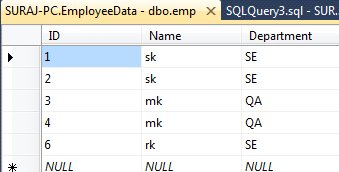CREATE FUNCTION [dbo].[fnSplit](
@sInputList VARCHAR(8000) -- List of delimited items
, @sDelimiter
VARCHAR(8000) = ',' -- delimiter that
separates items
) RETURNS @List TABLE (item VARCHAR(8000))
BEGIN
DECLARE @sItem VARCHAR(8000)
WHILE CHARINDEX(@sDelimiter,@sInputList,0) <> 0
BEGIN
SELECT
@sItem=RTRIM(LTRIM(SUBSTRING(@sInputList,1,CHARINDEX(@sDelimiter,@sInputList,0)-1))),
@sInputList=RTRIM(LTRIM(SUBSTRING(@sInputList,CHARINDEX(@sDelimiter,@sInputList,0)+LEN(@sDelimiter),LEN(@sInputList))))
IF LEN(@sItem) > 0
INSERT INTO @List SELECT
@sItem
END
IF LEN(@sInputList) > 0
INSERT INTO @List SELECT
@sInputList -- Put the last item in
RETURN
END
SELECT * FROM
dbo.[fnSplit]('1,2,3',',')
Another Function for the Same Is:
CREATE FUNCTION [dbo].[Split](@String nvarchar(4000), @Delimiter char(1))
RETURNS @Results TABLE (Items nvarchar(4000))
AS
BEGIN
DECLARE @INDEX INT
DECLARE @SLICE nvarchar(4000)
-- HAVE TO SET
TO 1 SO IT DOESNT EQUAL Z
-- ERO FIRST TIME IN LOOP
SELECT @INDEX = 1
WHILE @INDEX !=0
BEGIN
-- GET THE INDEX
OF THE FIRST OCCURENCE OF THE SPLIT CHARACTER
SELECT @INDEX = CHARINDEX(@Delimiter,@STRING)
-- NOW PUSH
EVERYTHING TO THE LEFT OF IT INTO THE SLICE VARIABLE
IF @INDEX !=0
SELECT @SLICE = LEFT(@STRING,@INDEX - 1)
ELSE
SELECT @SLICE = @STRING
-- PUT THE ITEM
INTO THE RESULTS SET
INSERT INTO @Results(Items) VALUES(@SLICE)
-- CHOP THE ITEM
REMOVED OFF THE MAIN STRING
SELECT @STRING = RIGHT(@STRING,LEN(@STRING) - @INDEX)
-- BREAK OUT IF
WE ARE DONE
IF LEN(@STRING) = 0 BREAK
END
RETURN
END
Now Execute the Function
SELECT * FROM dbo.[Split]('1-2-3','-')












